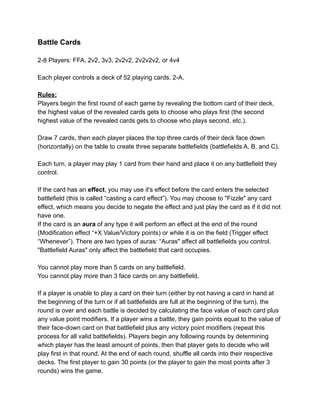More Related Content
Similar to Battle Cards (10)
Battle Cards
- 1. Battle Cards
28 Players: FFA, 2v2, 3v3, 2v2v2, 2v2v2v2, or 4v4
Each player controls a deck of 52 playing cards. 2A.
Rules:
Players begin the first round of each game by revealing the bottom card of their deck,
the highest value of the revealed cards gets to choose who plays first (the second
highest value of the revealed cards gets to choose who plays second, etc.).
Draw 7 cards, then each player places the top three cards of their deck face down
(horizontally) on the table to create three separate battlefields (battlefields A, B, and C).
Each turn, a player may play 1 card from their hand and place it on any battlefield they
control.
If the card has an effect , you may use it's effect before the card enters the selected
battlefield (this is called “casting a card effect”). You may choose to "Fizzle" any card
effect, which means you decide to negate the effect and just play the card as if it did not
have one.
If the card is an aura of any type it will perform an effect at the end of the round
(Modification effect “+X Value/Victory points) or while it is on the field (Trigger effect
“Whenever”). There are two types of auras: “Auras" affect all battlefields you control.
"Battlefield Auras" only affect the battlefield that card occupies.
You cannot play more than 5 cards on any battlefield.
You cannot play more than 3 face cards on any battlefield.
If a player is unable to play a card on their turn (either by not having a card in hand at
the beginning of the turn or if all battlefields are full at the beginning of the turn), the
round is over and each battle is decided by calculating the face value of each card plus
any value point modifiers. If a player wins a battle, they gain points equal to the value of
their facedown card on that battlefield plus any victory point modifiers (repeat this
process for all valid battlefields). Players begin any following rounds by determining
which player has the least amount of points, then that player gets to decide who will
play first in that round. At the end of each round, shuffle all cards into their respective
decks. The first player to gain 30 points (or the player to gain the most points after 3
rounds) wins the game.
- 3. C: Use one or two jokers as additional battlefields that can only store one card (the
effect of that card is used normally but these battlefields are not counted towards victory
at the end of the game, they merely provide additional spaces for card effects to affect
the battlefield). At any time they could normally play a card from their hand, any player
may instead sacrifice a card from any joker battlefield to use the card's effect.
D: Players can determine new and fun ways to play with jokers and share them with the
online community.
Variant 3: 5 Fields
This variant requires two different 52 card decks to be shuffled into one 104 card deck
for each player. Players start with 5 battlefields and 10 cards in hand. Each battlefield
can have up to 5 face cards and 10 cards all together.
Variant 4: Gambling/Drinking
This game can be modified in several different ways to accommodate wagered currency
or even become a drinking game!
A: "Penalty Prospects" Any time a player discards a card from their hand or places a
card from their field into any graveyard, they must pay the designated wager amount of
any single predetermined currency (usually nickles) or takes a drink of alcohol.
B: “Seasoned Liver" Any time a player plays a face card from their hand they must
take a drink of alcohol.
C: "Designated Value" After a turn order has been decided for a round, the person who
plays last may designate a card value to be the "Drinking Card" or “Ante Card”. Any time
a player plays the designated card value from their hand they may make target player
take a drink of alcohol or pay the designated wager amount of any single predetermined
currency (usually dimes).
Variant 5: Unlimited
Begin the game with "X" decks and "Y" battlefields per player. The game can progress
for "B" rounds or until a player reaches "C" points. Players decide the values of the
given variables before the game begins and can't be changed until the game has
ended.
Variant 6: Draft
Separate all cards from all decks into equal face up piles based on the value of each
card. Each player rolls the same dice to determine the draft order (The person who rolls
the highest value gets to choose who gets first pick, the person who rolls the second
highest value gets to choose who gets second pick, etc.). Each player takes turns
picking cards for their decks until all cards have been drafted and all players have a
deck of 5254 cards depending on the amount of jokers. You can choose to draft
normally (p1, p2, p3, p4, p1, etc.) or snake draft (p1, p2, p3, p4, p4, p3, p2, p1, p1, etc.).
© 2016 Gavin Brenner and Kelly Maloney

